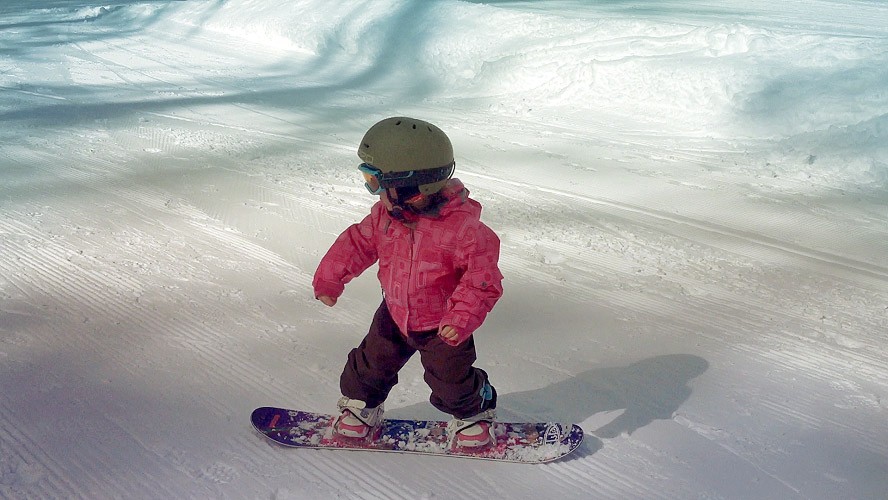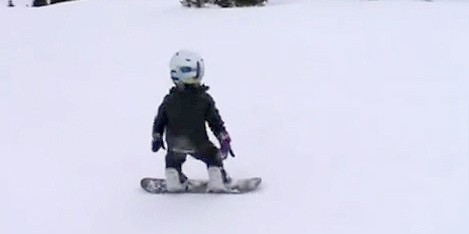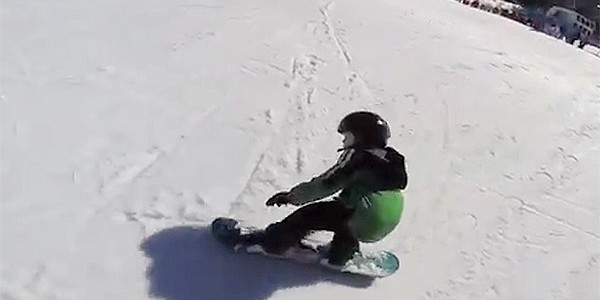Three is an exciting age to learn to snowboard and, if you and your kids are keen to get riding, then you can expect some great fun times on the snow.
From age around three a child’s ability to learn the basics on a snowboard starts to increase. Most children will be beginning to be more physically aware and autonomous; useful skills to have when it comes to learning to snowboard!
Current snowboard technology, teaching methods and equipment for young children really begin to come into their own for kids around 3 – be it easy flex, low edge catching kids snowboards, one strap easy on/off bindings, Riglet Parks or harness and Riglet reels. All these great developments, as well as an increase in age, can prolong time on the snow, thus increasing progression for younger children.
There are three words to bear in mind when teaching three year old’s to snowboard – give them TIME, be PATIENT and have FUN!
What to Expect
Expect a variety of outcomes after a weeks riding.
A three year old has every chance of beginning to understand and use edge control after a week – although primarily heel edge. They may be able to learn to stop and they may be able to ride straight down a very gentle slope independently – either stopping with the gradient of the slope or by themselves.
Expect that after a little bit of practice they may also be able to ride around fairly easy slopes with help from a harness – and a competent adult snowboarder to hold the harness!
Expect time on the board to have a bearing – with a longer amount of time on snow obviously the child can progress further.
Do expect fairly short sessions generally, from 10mins to up to 2 hours (with breaks) depending on the child, and a fair bit of wobbling at first
Expect a mix of responses from other people – ‘how cute!’ ‘how cool!’ ‘how dangerous!’ ‘they should be skiing first!’ etc.
General Guidelines
As with any age, keep anytime on the snow as FUN as you can! Intersperse sessions on snow with fun games, hot chocolate breaks and sledging.
Find easy forgiving slopes to start on with easy access – ie. travelators or rope tows – so you’re not pushing them up too many times and they’re not walking up too many times! At this age it’s much more beneficial for them to keep all their energy for riding not walking up slopes.
Try and use a variety of techniques and methods to teach them:
- be hands on at first – keeping hold of them whilst they get used to the board, then let them practice ‘gliding’ on their own; between parents or from a gentle incline to flat.
- You could also use a harness – good for practice on higher slopes.
- Or get them into a Burton Riglet park if you can – with Riglet Park snowboard instructors too if available and if possible.
- Don’t push them but do encourage them to keep trying. Give them time – more than you think – to get used to the board and praise their efforts.
Initially progress might be slow and you might think that perhaps they are ‘too young to start snowboarding’ but after a few days you should see them progressing – that’s the fun bit!
Remember every child is different – some may take to snowboarding well at a young age and some may enjoy it more later on. The main goal is for them to enjoy being in the snow and, hopefully, enjoy being strapped into a snowboard (even if only for a short amount of time!) – sowing seeds for years of future riding fun.
How to – Practical advice and Tips
First Time on Snow
WHAT TO WEAR?
- Layers are a good solution – good for keeping warm, easy to take off when they get hot.
- ‘Bibbed’ dungaree style snowboard pants and all-in-ones are brilliant – they keep the snow out and there’s always lots of bending and rolling about when kids and snow are involved! Toilet stops can take a bit longer however!
- Always make sure they have good, waterproof gloves. And also a good warm helmet with goggles too. Keep sunglasses and a beanie handy for when they stop as they may want to take off their helmet & goggles. And a cold child will be a miserable child!
- Other than a helmet, extra body protection is up to you. At first, lots of bulky body armour is likely to impede their movement – so not ideal for learning. However as they get a lot better you may want to think about back protectors, knee & elbow pads, impact shorts and wrist guards. This is a personal choice and they will probably only need to be seriously kitted about when they are thinking about hitting boxes and jumps or if they are really seriously kamikaze!
- For more info see our Equipment Guide.
WHICH SLOPES?
- Choose a very easy, quiet, safe slope with a very gentle incline. This doesn’t have to be a designated ‘beginner area’ at first; anywhere quiet, snowy (use caution or choose another day or slope if it’s icy) with a low gradient
ADVICE ON LIFTS
- It’s great if you have access to an easy slope with a travelator, rope tow or even an easy chairlift – brilliant fun for the kids and less exhausting for Mum & Dad!
- However, be aware that with a chairlift your little one will need to be lifted on and either carried or guided off – make sure you are competent on chairlifts if you are accompanying them.
- Button lifts will take some practice and probably not for day one! You will have to gauge if the button lift is a good size, length and speed for your child; button lifts can be tricky at first for even hardened adult snowboarders. Thankfully, beginner areas usually have easier, slower button lifts with good access should you need to rescue a fallen child!
- On all lifts, you and your child will probably find it much easier initially if both of your child’s feet are strapped into their bindings (practicing one-footed can come later).
PRE SNOW
Get them used to the equipment if you can:
- Try on a snowboard, boots & bindings, helmet & goggles and even all their winter clothing!
- Show them how to strap into their bindings and let them try too
- Letting them stand and jump around on the board (make sure it’s on carpet or grass or somewhere the board won’t get damaged or it’s edges damage surfaces, furniture etc)
- Definitely pull them around the carpet, lift them up on the board etc – getting them to enjoying ‘playing about’ on the board. Hopefully it will then feel more familiar when they try it on snow.
- Explain very basically, just as an introduction, what the basic parts of the board and bindings are – ie. nose, tail, heel & toe edges.
- Have the kids stand sideways and practice looking and pointing in the direction they want to go
- Keep it fun – don’t try and teach them anything too technical at this stage!
Regular or Goofy?
Whether your child is regular or goofy ie.if they lead with their left foot forward (regular) or the right (goofy) may not be apparent straight away. Most kids boards are a twin tip design – meaning they can be ridden either way so don’t worry too much at first. Set the bindings up in a fairly neutral position (don’t be tempted to go really ‘duck footed’ (ie.both toes pointed outwards to a big degree) as this won’t be helpful with their balance. Watch to see if they favour a certain foot or direction and you can change their set up accordingly.
Balance & First techniques
If you are able to put your child into a lesson with an instructor trained in teaching very young children and with specific facilities (see our Snowboard Schools Guide) then that is always a good way to go. However, availability, price and child temperament means that this is not always a viable option. The following are a few techniques you can use to help teach your child or build on what they have been taught:
- Initially you can start by just pulling them along – eg with a Riglet Reel or holding their hands – on the flat of the board so they get used to the feeling of the board
- Then they can move onto riding and gliding on the flat of the board between parents. Explain they must look where they are going, getting them to point with their leading hand with their trailing hand behind them or on their hip is a good way to help them keep a ‘standing sideways’ position.
- When the are confident with this you can hold their hands and walk them through some heel and toe turns – this will introduce them to edges and turning
- If you are confident in your riding you can also ride with your child (holding their hands/arms) going through heel and toe turns and even over small jumps; but only if you are a very confident rider and have a very tight hold! And you will have to lift/carry them over the jumps, obviously.
- Keep things fun and full of games; ask them to be a teapot (trailing hand on hip and front ‘spout’ hand over the nose of the board) and to follow their spout down the slope looking to give people cups of tea! Or that they have a big bucket of water that they have to balance over the nose of their board etc (these sort of games help them keep sideways on the board)
- Try to work towards getting them to stop of their own accord. So ask them to follow their hand and point back up the slope so they use their heel edge to stop themselves. This may not come for a while, so go at their pace and don’t push things.
- Skating/one-footed is not recommended at first
- Get them to practice flipping over from sitting to being on their knees and getting up on their own from sitting or from their knees – although bear in mind this is tiring for them.
- They don’t need instruction all the time – they need mileage, practice and time.
- Some parents use innovative techniques to get their kids riding – check out this double snowboard! (Tandem Riding!)
- Remember that learning initially is really about the kids getting comfortable on their boards, not rapid progression – practice with patience and you will soon all be ripping around on the snow!
Check out our Age 3 Video section for clips of how other three year old’s and their families have got on.
Equipment
Other than appropriate winter clothing kids will need a snowboard, snowboard boots, bindings, a snowboard helmet and goggles.
Snowboards
Depending on their height and weight, generally, a 3 year old would use between an 80 and 90cm child’s snowboard (or even 95-105cm if heavier/larger than average or if nothing else is available). A board should be up to about chin or shoulder height. It is best to go for a smaller size for a first board as it will be easy to turn/handle.
Try and source a newer, child-specific snowboard; they are a few different types – look out for any terms that mention making it much harder for the rider to catch edges, easier to turn, and all with a nice soft flex!
For more info see the Snowboards section
Bindings & Boots
For bindings; small, one strap,child specific ones if possible. And appropriate sized boots (try sourcing these before you hit the slopes because although more and more places stock small snowboard equipment it is still a fairly limited to hire or buy – especially with boots.
For more info see the Bindings Section and Snowboard Boots Section
Also see all categories in our Equipment Guide Section
Aside from the basics there are also other bits of kit that you may find useful when going out on snow with your little ones:
Harnesses and Riglet Reels
Both harnesses and Riglet Reels are methods of helping young kids learn to snowboard that involve an attachment to either the rider (harnesses) or the board (Riglet) and an adult.
Both come highly recommended and can be invaluable in helping the get your little ones riding.
So to find out more visit the Harnesses and Riglet Reels section of our Equipment guide.

Technical Info Bit!
Kids have a different centre of gravity, head weight and muscle mass than adults so learn differently.
So when they start to learn to control the board and edge control, don’t worry if they use different techniques than adults as this is all very normal for young children.
i.e. they may use a different stance on their boards in order to find their balance and complete turns. They may rely more on their heel edge and they may lean over their back foot more.
As children learn, grow and adapt their riding will change, so don’t panic if they’re not stylin’ it initially – it won’t be long until they’re out riding you!
See more in our ‘Technical Advice‘ Section.
The difference it made to my daughters riding when she went from an older, stiffer board to a newer one was incredible – so if you want to help them progress it is definitely something to get right!
Have a look at the videos below of a couple of three year old’s snowboarding, hopefully you will find them helpful.
Don’t forget you can also see more three year old’s in our Age Three video section and to see some children who are really pushing the boundaries of kids snowboarding check out our Kids Who Ride Section…





